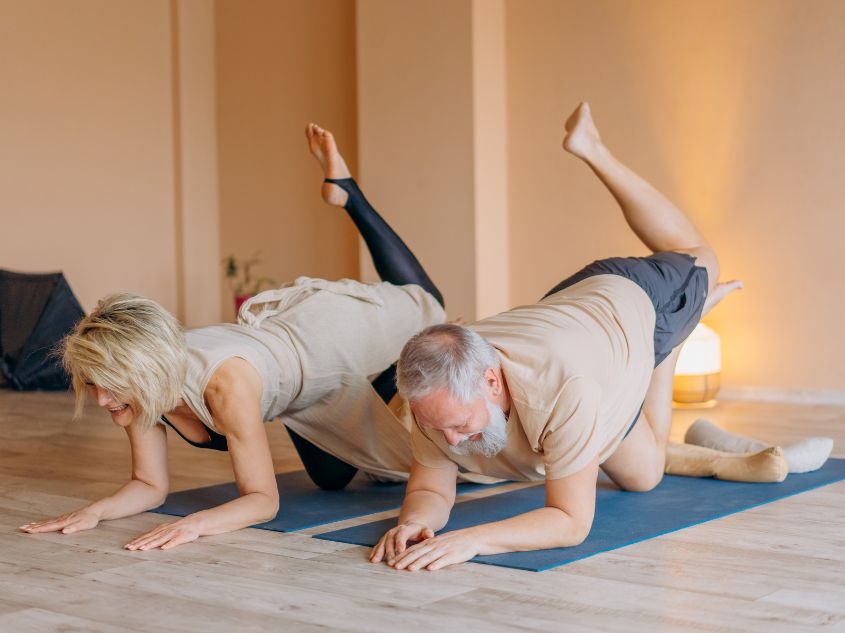Resistance bands are a popular fitness tool. Not only are they convenient but they are also a versatile and challenging way to strengthen and tone various muscle groups, whether you're a beginner or a seasoned fitness enthusiast looking to take your body to the next level.
Understanding resistance bands
Resistance bands are flexible bands made of latex or rubber that come in various shapes and sizes. They offer different levels of resistance and can be used for a wide range of exercises. Resistance bands can be categorized into loop bands, power bands, fabric, and even tube bands with handles. Each has its own unique benefits.
Power resistance bands are specifically designed to offer higher levels of resistance, making them ideal for resistance training and building muscle. These bands are typically thicker and sturdier than regular bands, allowing you to perform more challenging exercises and target specific muscle groups with greater intensity.
Benefits of doing exercises with bands
As one article published by Science in Sports & Exercise points out, resistance training improves “athletic performance by increasing muscular strength, power and speed, hypertrophy, local muscular endurance, motor performance, balance, and coordination”.
Resistance bands are able to provide continuous tension throughout the entire range of motion while you exercise, engaging your muscles more effectively. By adding resistance to exercises such as the plank, hamstring curls, core workouts, squats, bent-over rows, and bench presses, you can stimulate muscle growth and enhance your overall strength.
Power resistance bands, for instance, are highly versatile and can be used to target various muscle groups, including the arms. They can be easily incorporated into your existing workout routine, whether you prefer training at home, at the gym, or while traveling. Their compact size makes them portable, allowing you to carry them anywhere and continue your workouts without relying on bulky equipment.
Resistance bands allow for low-impact workouts that put less strain on your joints compared to heavy weights or machines. Adjustable resistance levels allow you to find the right balance between challenging your muscles and protecting your joints, making resistance bands suitable for those with joint issues or those in need of rehabilitation exercises.
Performing exercises with resistance bands requires stabilization, and engaging your core muscles throughout the movements. This not only helps strengthen your core but also enhances overall stability and balance. Exercises like plank variations and core-specific movements with resistance bands can effectively target and strengthen your abdominal muscles.
6 Essential exercises using resistance bands
1. Plank Arm Rows
Plank arm rows are a compound exercise that targets the arms, shoulders, and core muscles. Start in a plank position with the resistance band wrapped around your hands. While maintaining a stable core, pull one hand towards your chest, keeping the elbow close to the body. Alternate the movement between each arm.
2. Hamstring Curls with Bicep Curls
Combining hamstring curls with bicep curls creates a dynamic exercise that engages multiple muscle groups simultaneously. Stand on the center of the resistance band and hold the handles. Curl your biceps while simultaneously bending one knee, bringing your heel towards your glutes. Alternate the movement between each leg.
3. Core-Engaging Arm Extensions
Arm extensions with resistance bands target the core muscles, shoulders, chest, and triceps. Stand with one foot forward and step on the resistance band. Hold the handles at shoulder height with your palms facing forward. Extend your arms forward, keeping them parallel to the ground. Engage your core muscles throughout the movement.
4. Squat to Overhead Press
Squat to overhead press is a compound exercise that targets the lower body, shoulders, and arms. Stand on the resistance band with your feet shoulder-width apart. Hold the handles at shoulder height with your palms facing forward. Lower into a squat position while keeping your chest lifted. As you stand back up, press the handles overhead, extending your arms fully.
5. Bent-Over Rows
Bent-over rows with resistance bands target the upper back, biceps, and shoulders. Stand on the center of the resistance band, feet hip-width apart. Hinge forward at the hips while keeping your back straight and chest lifted. Hold the handles with your palms facing each other. Pull the handles towards your torso, squeezing your shoulder blades together.
6. Bench Press with Resistance Bands
Performing the bench press with resistance bands adds extra resistance to the exercise, challenging your chest, shoulders, and triceps. Secure the resistance band around a sturdy post or anchor point behind you. Lie on a bench facing up and hold the handles with your palms facing away from you. Extend your arms fully, then lower the handles towards your chest, and press back up.
Unlocking the full power of resistance bands
- Choose the Right Resistance Level: resistance bands come in different levels of resistance. Start with a band that challenges your muscles without compromising your form. As you get stronger, you can gradually increase the resistance by using thicker bands.
- Proper Form and Technique: maintain proper form during exercises to maximize the benefits and reduce the risk of injury. Follow the instructions for each exercise carefully, focusing on the targeted muscle group and controlling the movement. Avoid jerking or using momentum to perform the exercises.
- Incorporate Power Resistance Bands into Your Routine: integrate resistance band exercises into your existing workout routine for a comprehensive and effective training session. You can use them as a standalone workout or incorporate them into circuits or supersets to add variety and intensity to your training.
- Progression and Variation: as your strength and endurance improve, challenge yourself by increasing the resistance or trying different exercises. There are numerous variations and modifications available for each muscle group, allowing you to continuously progress and avoid plateaus in your training.
Resistance bands are a versatile and effective tool for enhancing your workouts and overall strength training routine, for increased muscle activation, versatility, and convenience. These bands can be used to target multiple muscle groups, improve stability and core strength, and provide joint-friendly workouts.
Grab your own set of resistance bands and unlock the power of resistance training today!
Safety Precautions
To ensure maximum safety while using resistance bands, inspect them regularly for any signs of wear or damage. Replace worn-out bands to prevent accidents.
Be mindful of your body's limits and avoid overstretching or using bands that are too strong for your current strength level. If you experience pain or discomfort during an exercise, stop and consult a fitness professional or healthcare provider.
When using resistance bands, it is important to choose the appropriate resistance level for you, while you maintain proper form and technique, and gradually progress as your strength improves.



